Quick Look
Grade Level: 5 (3-5)
Time Required: 45 minutes
Expendable Cost/Group: US $3.00
Group Size: 4
Activity Dependency: None
Subject Areas: Biology
Summary
Students filter different substances through a plastic window screen, different sized hardware cloth and poultry netting. Their models show how the thickness of a filter in the kidney is imperative in determining what is filtered out and what stays in the blood stream.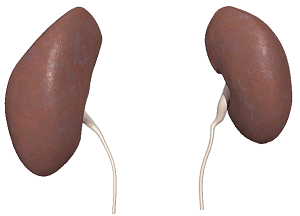
Engineering Connection
Engineers design many different filters that help people live healthier lives. Engineers design filters to clean water, and they also design special filters called dialysis machines. This equipment, essentially a special filter, cleans blood for people whose kidneys are not working correctly.
Learning Objectives
After this activity and accompanying worksheet, students should be able to:
- Explain the role of the kidney as a filtering system for blood.
- Describe the by-products of the excretory system.
- Model the filtering function of a kidney on a larger scale.
- Give examples of filters designed by engineers, such as dialysis machines.
Educational Standards
Each TeachEngineering lesson or activity is correlated to one or more K-12 science,
technology, engineering or math (STEM) educational standards.
All 100,000+ K-12 STEM standards covered in TeachEngineering are collected, maintained and packaged by the Achievement Standards Network (ASN),
a project of D2L (www.achievementstandards.org).
In the ASN, standards are hierarchically structured: first by source; e.g., by state; within source by type; e.g., science or mathematics;
within type by subtype, then by grade, etc.
Each TeachEngineering lesson or activity is correlated to one or more K-12 science, technology, engineering or math (STEM) educational standards.
All 100,000+ K-12 STEM standards covered in TeachEngineering are collected, maintained and packaged by the Achievement Standards Network (ASN), a project of D2L (www.achievementstandards.org).
In the ASN, standards are hierarchically structured: first by source; e.g., by state; within source by type; e.g., science or mathematics; within type by subtype, then by grade, etc.
NGSS: Next Generation Science Standards - Science
-
A system can be described in terms of its components and their interactions.
(Grades 3 - 5)
More Details
Do you agree with this alignment?
-
Use a model to test interactions concerning the functioning of a natural system.
(Grade 4)
More Details
Do you agree with this alignment?
-
Make observations and/or measurements to produce data to serve as the basis for evidence for an explanation of a phenomenon.
(Grade 4)
More Details
Do you agree with this alignment?
Common Core State Standards - Math
-
Fluently multiply and divide within 100, using strategies such as the relationship between multiplication and division (e.g., knowing that 8 × 5 = 40, one knows 40 ÷ 5 = 8) or properties of operations. By the end of Grade 3, know from memory all products of two one-digit numbers.
(Grade
3)
More Details
Do you agree with this alignment?
-
Solve multistep word problems posed with whole numbers and having whole-number answers using the four operations, including problems in which remainders must be interpreted. Represent these problems using equations with a letter standing for the unknown quantity. Assess the reasonableness of answers using mental computation and estimation strategies including rounding.
(Grade
4)
More Details
Do you agree with this alignment?
-
Add, subtract, multiply, and divide decimals to hundredths, using concrete models or drawings and strategies based on place value, properties of operations, and/or the relationship between addition and subtraction; relate the strategy to a written method and explain the reasoning used.
(Grade
5)
More Details
Do you agree with this alignment?
-
Fluently multiply multi-digit whole numbers using the standard algorithm.
(Grade
5)
More Details
Do you agree with this alignment?
International Technology and Engineering Educators Association - Technology
-
Students will develop an understanding of the relationships among technologies and the connections between technology and other fields of study.
(Grades
K -
12)
More Details
Do you agree with this alignment?
-
Students will develop an understanding of and be able to select and use medical technologies.
(Grades
K -
12)
More Details
Do you agree with this alignment?
-
Technological advances have made it possible to create new devices, to repair or replace certain parts of the body, and to provide a means for mobility.
(Grades
3 -
5)
More Details
Do you agree with this alignment?
State Standards
Colorado - Math
-
Fluently multiply and divide within 100, using strategies such as the relationship between multiplication and division or properties of operations.
(Grade
3)
More Details
Do you agree with this alignment?
-
Solve multistep word problems posed with whole numbers and having wholenumber answers using the four operations, including problems in which remainders must be interpreted.
(Grade
4)
More Details
Do you agree with this alignment?
-
Add, subtract, multiply, and divide decimals to hundredths.
(Grade
5)
More Details
Do you agree with this alignment?
-
Fluently multiply multi-digit whole numbers using standard algorithms.
(Grade
5)
More Details
Do you agree with this alignment?
Colorado - Science
-
Create and evaluate models of human body systems and organs
(Grade
5)
More Details
Do you agree with this alignment?
Materials List
Each group needs:
- 6-inch square pieces of each of the following:
- plastic window screening
- hardware cloth (½" mesh)
- hardware cloth (¼" mesh)
- hardware cloth (1/8" mesh)
- poultry netting (1" holes)
- 1-2 sheets of newspaper (to cover desk)
- 2 measuring cups or bowls (about 4 cups each)
- large funnel (large enough to have large pebble flow through the neck)
- ½ cup sand
- ½ cup small pebbles in various sizes from 1/8" to >1"
- ½ cup water
- Filtering System Journal, 4 copies
- Filtering Worksheet, 4 copies
To bind the screens for safety:
- duct tape
Optional materials:
- (optional) round coffee filter
- (optional) 2 tbsp. flour (only needed if using a coffee filter)
Worksheets and Attachments
Visit [www.teachengineering.org/activities/view/cub_human_lesson08_activity1] to print or download.Introduction/Motivation
To which human body system do the kidneys belong? The excretory ─ or urinary system! This is an important body system because it helps us remove any harmful substances from our body. The kidneys actually work as a filtering system for our blood. They take blood in from the bloodstream, remove waste products (such as salt, minerals and any toxins, or bad stuff) and combine them with water. Then the body gets rid of this water and waste combination, known as urine. The kidney, in a healthy adult, can process as much as 45 liters of water a day, releasing only 1-2 liters in the form of urine.
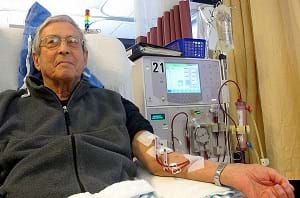
Engineers have designed many amazing filtering systems. They have designed systems to filter bad stuff out of water so that people can have clean water to drink, which helps us stay healthy. They have designed filters to remove harmful particles from the air, so we can have clean air to breathe. They even design filters to prevent unwanted noise from coming through on our phones. Engineers also design special filters for people in the hospital or who have medical problems. Many of the machines that you see in hospitals have been designed by engineers.
Sometimes people have kidneys that do not work well, so engineers have designed a special machine, called a dialysis machine, which filters their blood when their kidneys can not. A dialysis system removes a person's blood through a tube, runs it through filters to remove wastes and extra fluids, and then returns the clean blood to their body. It is a truly amazing system! The dialyzer consists of thousands of small fibers. The blood runs through the fibers, and a cleansing solution runs along the outside of the fibers. The solution acts like a sponge, and it soaks up the extra fluid and waste from the blood. The dirty solution is discarded, and the clean blood gets returned to the body.
Today we are going to test some filter materials and decide which ones work best for removing objects from water. Although these filter models are larger than an actual kidney, they help us investigate how kidneys filter waste from our blood. Also, the model allows us to understand how engineers can design filters to create dialysis machines for people whose kidneys are not working properly.
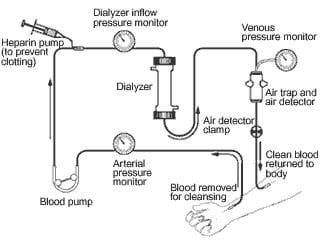
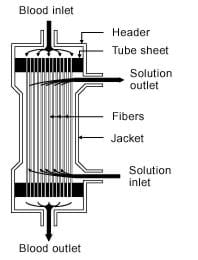
Procedure
Before the Activity
- Cut screening, poultry netting, and hardware cloth to the proper size.
- Bind the poultry netting and hardware cloth with duct tape to cover sharp edges (see Figure 4).
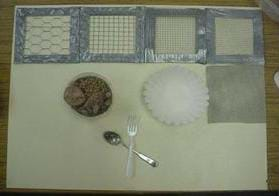
- Assemble all necessary materials.
- Prepare overhead of the Excretory System (attached).
With the Students
- Show students the Excretory System overhead. Ask students to help you identify the location of the kidneys, bladder and ureters. Have students write down these terms under the Vocabulary section of the Filtering System Journal.
- Remind students that the kidneys are a filtering system for the blood. Explain that engineers design dialysis machines for people whose kidneys are not working properly. Have students write a few sentences about how the kidney functions under "I've Learned" on their journal sheets.
- Explain that this activity is a model for how the kidney cleans the blood. Students should be clear that this is just a model and that the kidney does not actually filter solids, except for blood cells. The products filtered through the screens in the activity are meant to represent the waste products in the blood, which are excreted in urine. Urine contains glucose, sodium, potassium, bicarbonate, water, acid, blood cells, protein and urea (which is what makes urine yellow).
- Students should mix the sand, pebbles, flour (optional) and water in the first measuring cup or bowl, as shown in Figure 4.
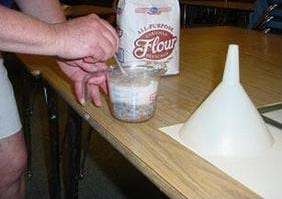
- The students should take turns filtering the water mixture through the funnel, poultry netting, different-sized hardware cloth, window screening and coffee filter (optional), from large-filter holes to small-filter holes (see Figure 6). The screening should be held over the second measuring cup/bowl. Students should then pour the mixture from the full measuring cup/bowl onto the screen over the empty container and then back again, using a different screen each time.
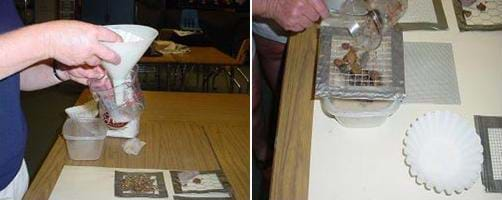
- Students should complete the Observations section of the Filtering System Journal.
- Discuss with the students what they have learned and have them work through the Filtering Worksheet. Ask the students how the filter model they created might be used by engineers in creating dialysis machines. Have students write down any other things they have learned in their Filtering System Journal under the "I've Learned" section, and answer any questions the students may have written in the "Questions I Have" section of their journal.
Vocabulary/Definitions
dialysis: The process of separating substances in solution by diffusion through semipermeable membranes.
dialysis machine: Equipment that filters blood when the kidneys cannot.
hemodialysis: The process that refers specifically to purifying blood by dialysis.
Assessment
Pre-Activity Assessment
Vocabulary: Have students write down the terms kidneys, excretory system, ureters and bladder under the Vocabulary section of the Filtering System Journal. Have them discuss with a neighbor what these terms mean and write short definitions next to the terms.
Activity Embedded Assessment
Worksheet/ Observations: Explain to students that engineers and scientists record their observations while they are working with a model. Using the Filtering System Journal, ask them to write down anything they noticed during the activity in the "Observations" section of their journal, and any questions they might have in the "Questions I Have" section. Review their answers to gauge their mastery of the subject.
Post-Activity Assessment
Discussion: Lead a discussion out loud, asking students what they have learned about filters and engineering. Have students write down the things they have learned in their Filtering System Journal under the "What I've Learned" section. Make sure to answer any questions the students may have written in the "Questions I Have" section of their journal.
Math Extension: Have students work through the Filtering Worksheet. Remind students that there are numbers that engineers would need to know in order to size a dialysis machine properly.
Safety Issues
Be careful when handling the sharp edges of the mesh screening.
Troubleshooting Tips
Use a large enough container to contain the poured water.
Activity Extensions
Have students research engineering systems that use filters (water treatment systems, waste water treatment systems, etc.) Remind students that many engineered systems actually are designed with knowledge that engineers have learned through science and nature.
Invite a medical technician to speak to the class about dialysis machines.
Activity Scaling
For upper grades, explain more of the details of how a dialysis machine works. Some students may have a friend or relative who is or has been on dialysis. Talk about what qualities are important to consider when designing a dialysis machine (sterility, work as similar to the body's function as possible, comfort level of the patient, ease of use for the patient and nurse/aide, etc.). Check out https://www.niddk.nih.gov/health-information/kidney-disease/kidney-failure/hemodialysis for more information on dialysis. Have students complete the challenge section of the math worksheet.
For lower grades, discuss why we use the filters in order of largest to smallest mesh size, and not the other way around. Talk with students about how in mathematics and in many engineering applications ─ (as well as in life!) ─ the order in which we do things is very important. Doing things in the correct order helps us achieve and understand the outcomes of a model. The math worksheet may not be appropriate for students under 3rd grade.
Subscribe
Get the inside scoop on all things TeachEngineering such as new site features, curriculum updates, video releases, and more by signing up for our newsletter!More Curriculum Like This

This lesson helps students explore the functions of the kidney and its place in the urinary system. Students learn how engineers design instruments to help people when kidneys are not functioning properly or when environmental conditions change, such as kidney function in space.

Using ordinary classroom materials, students act as biomedical engineering teams challenged to design prototype models that demonstrate semipermeability to help medical students learn about kidney dialysis. A model consists of two layers of a medium separated by material acting as the membrane. Grou...
References
U.S. Department of Health and Human Services, National Institutes of Health, National Institute of Diabetes and Digestive and Kidney Diseases, National Institutes of Health, National Kidney and Urologic Diseases Information Clearinghouse (NKUDIC), NIH Publication No. 06–4281, March 2006, "Prevent Diabetes Problems: Keep Your Kidneys Healthy," http://diabetes.niddk.nih.gov/dm/pubs/complications_kidneys/
U.S. Department of Health and Human Services, National Institutes of Health, National Institute of Diabetes and Digestive and Kidney Diseases, National Institutes of Health, National Kidney and Urologic Diseases Information Clearinghouse (NKUDIC), NIH Publication No. 03–4666, September 2003, "Treatment Methods for Kidney Failure: Hemodialysis," http://kidney.niddk.nih.gov/kudiseases/pubs/hemodialysis/
Copyright
© 2006 by Regents of the University of ColoradoContributors
Jessica Todd; Emily Weller; Sara Born; Abigail Watrous; Denali Lander; Malinda Schaefer Zarske; Janet YowellSupporting Program
Integrated Teaching and Learning Program, College of Engineering, University of Colorado BoulderAcknowledgements
The contents of this digital library curriculum were developed under grants from the Fund for the Improvement of Postsecondary Education (FIPSE), U.S. Department of Education and National Science Foundation (GK-12 grant no. 0338326). However, these contents do not necessarily represent the policies of the Department of Education or National Science Foundation, and you should not assume endorsement by the federal government.
Last modified: September 11, 2019







User Comments & Tips